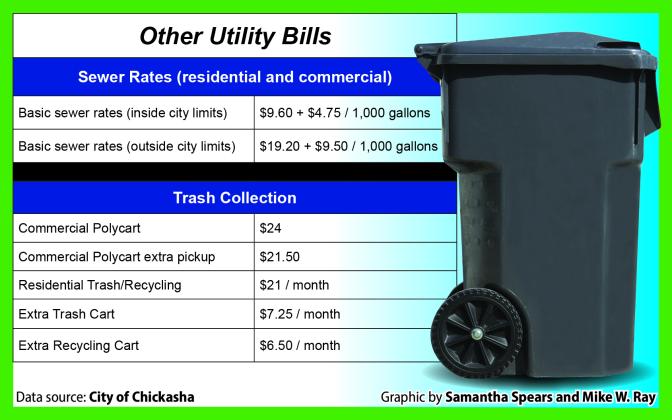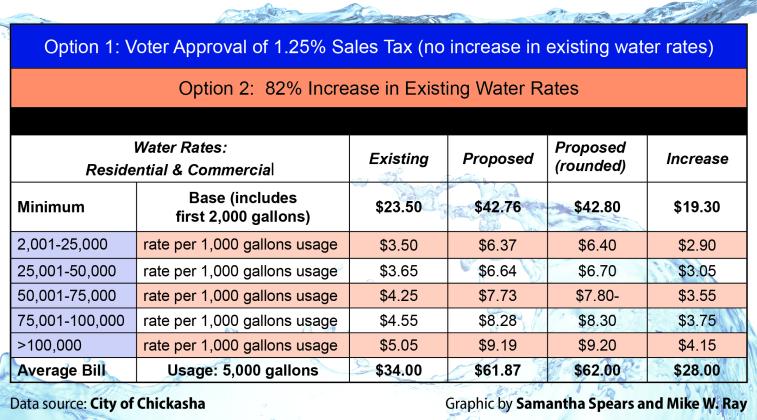By Southwest Ledger Editorial Board
The special-election ballot that Chickasha voters receive on Aug. 8 will offer two options for financing construction of a modern water treatment plant: renewing and increasing an expiring capital improvement sales tax by half a penny, to 1.25 cents per dollar, or raising local water rates 82%.
Some critics note the regressive nature of a sales tax. That is true; taxpayers on the lower end of the income scale pay a greater share of their disposable income in sales taxes than do wealthier individuals.
However, a sales tax is spread across a broad customer base and is paid not only by local residents but also by tourists and other visitors who spend money while in town.
Using sophisticated Placer foot-traffic location and dwell-time software, the Economic Development Council reported that 1.33 million out-of-towners visited Chickasha during the first seven months of this year, 116,000 of them in July alone. It’s a safe assumption that many of those visitors got thirsty and hungry during their time in town and perhaps spent a night or two in a local motel.
The combined city and state sales tax rate in Chickasha is 9 cents per dollar, or 90¢ per $10. The new combined rate would be just a nickel higher, 95¢ per $10, if voters approve the modest tax hike.
If the sales tax measure fails, City Council members previously voted to automatically raise water rates on Oct. 1, 2023, to pay off the OWRB loan.
Under that scenario, the monthly water bill for an “average” utility customer whose household usage is about 5,000 gallons of water per month would nearly double: from $34/month to $62. And that wouldn’t include the utility bills for sewer and trash collection/disposal. (See accompanying charts.)
The $72 million loan the Oklahoma Water Resources Board extended to the Chickasha Municipal Authority to finance the bulk of the new treatment plant will be retired over a maximum of 31 years. That’s a long time to pay an inflated water bill – and out-of-towners wouldn’t be sharing that expense.
City officials estimate the 1.25% sales tax would produce approximately $4.67 million each year – from residents and visitors alike – enough to retire the OWRB loan and to fund other capital improvements.
The debt service requirement on Chickasha’s loan – the amount needed each year to meet the principal and interest payments – would be approximately $3 million, city officials believe, leaving ample revenue for other projects.
The city has several other major capital improvement needs, including the wastewater system, storm drainage, improvements to public safety facilities, and much-needed repairs to crumbling streets and leaking water lines.
Ten years ago, in 2013, Guernsey, a highly respected engineering firm, conducted an analysis of Chickasha’s water system.
Guernsey estimated that the bulk of the water treatment plant had a service life of 10 more years. Today is now the tomorrow that was discussed yesterday.
“We’re at risk of not being able” to meet demands imposed on the water delivery system, City Manager Keith Johnson told the City Council earlier this year. Chickasha’s water treatment plant has several “deficiencies,” he noted.
The existing water treatment plant is believed to be at least 60 years old, and perhaps even older. Regardless of which birth certificate is accurate, the water plant has already surpassed its design capacity and useful life.
The facility was designed to produce 6 million gallons of pure, disinfected water each day but now “provides a maximum of 4.6 million gallons daily” to Chickasha and the nearby community of Norge, the city manager said.
Issues with the treatment plant a decade ago included pumps that were “suspect,” pump switchgear that was “antiquated,” and clearwells that were already “past their useful life.” [A clearwell is a component of a municipal drinking water purification system where water is held after the filtration and disinfection stages. The filtered water is held in a storage basin to allow the disinfectant to inactivate any remaining pathogens.]
Guernsey recommended building a new 2-million-gallon clearwell and a new treatment plant capable of producing 8 million gallons of treated water each day “to accommodate potential City development.” Remember: These improvements were recommended 10 years ago.
The state Department of Environmental Quality issued a consent order in December 2021 that directed the Chickasha Municipal Authority to make several improvements to its water plant. Some of those issues have been resolved but several others have not yet been corrected.
The new facility envisioned by the Municipal Authority will be capable of producing up to 6 million gallons of potable water daily “with provisions to expand to 8 mgd.” The treatment process would include pretreatment, clarification, filtration and disinfection, the Authority said.
An automobile manufactured in 1963 was unable to travel 30 miles on a gallon of gasoline, but that’s average for many cars built today. Science and technology have achieved similar profound advancements in water purification during the last 60 years.
Chickasha’s aged water treatment plant should have been replaced years ago, but wasn’t. That’s ancient history. The City Council has decided that Chickasha can’t afford to wait any longer. The only question remaining is how to pay for the new facility.
The clearly logical answer is a modest half-penny increase in the city sales tax.



